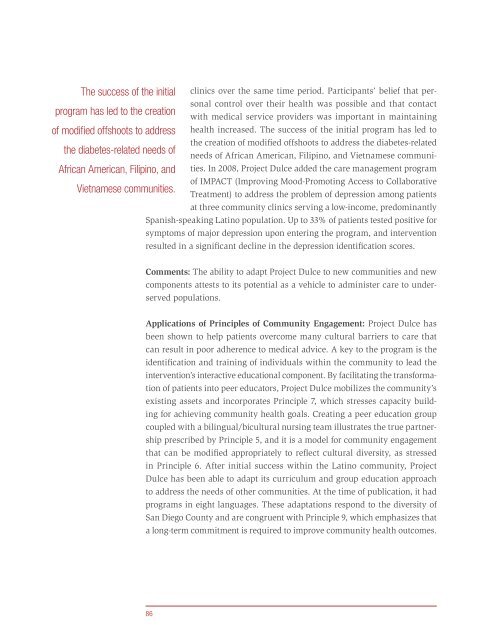Principles of Community Engagement (Second Edition)
Principles of Community Engagement (Second Edition)
Principles of Community Engagement (Second Edition)
You also want an ePaper? Increase the reach of your titles
YUMPU automatically turns print PDFs into web optimized ePapers that Google loves.
The success <strong>of</strong> the initial<br />
program has led to the creation<br />
<strong>of</strong> modified <strong>of</strong>fshoots to address<br />
the diabetes-related needs <strong>of</strong><br />
African American, Filipino, and<br />
Vietnamese communities.<br />
86<br />
clinics over the same time period Participants’ belief that per-<br />
sonal control over their health was possible and that contact<br />
with medical service providers was important in maintaining<br />
health increased The success <strong>of</strong> the initial program has led to<br />
the creation <strong>of</strong> modified <strong>of</strong>fshoots to address the diabetes-related<br />
needs <strong>of</strong> African American, Filipino, and Vietnamese communities<br />
In 2008, Project Dulce added the care management program<br />
<strong>of</strong> IMPACT (Improving Mood-Promoting Access to Collaborative<br />
Treatment) to address the problem <strong>of</strong> depression among patients<br />
at three community clinics serving a low-income, predominantly<br />
Spanish-speaking Latino population Up to 33% <strong>of</strong> patients tested positive for<br />
symptoms <strong>of</strong> major depression upon entering the program, and intervention<br />
resulted in a significant decline in the depression identification scores<br />
Comments: The ability to adapt Project Dulce to new communities and new<br />
components attests to its potential as a vehicle to administer care to underserved<br />
populations<br />
Applications <strong>of</strong> <strong>Principles</strong> <strong>of</strong> <strong>Community</strong> <strong>Engagement</strong>: Project Dulce has<br />
been shown to help patients overcome many cultural barriers to care that<br />
can result in poor adherence to medical advice A key to the program is the<br />
identification and training <strong>of</strong> individuals within the community to lead the<br />
intervention’s interactive educational component By facilitating the transformation<br />
<strong>of</strong> patients into peer educators, Project Dulce mobilizes the community’s<br />
existing assets and incorporates Principle 7, which stresses capacity building<br />
for achieving community health goals Creating a peer education group<br />
coupled with a bilingual/bicultural nursing team illustrates the true partnership<br />
prescribed by Principle 5, and it is a model for community engagement<br />
that can be modified appropriately to reflect cultural diversity, as stressed<br />
in Principle 6 After initial success within the Latino community, Project<br />
Dulce has been able to adapt its curriculum and group education approach<br />
to address the needs <strong>of</strong> other communities At the time <strong>of</strong> publication, it had<br />
programs in eight languages These adaptations respond to the diversity <strong>of</strong><br />
San Diego County and are congruent with Principle 9, which emphasizes that<br />
a long-term commitment is required to improve community health outcomes

















